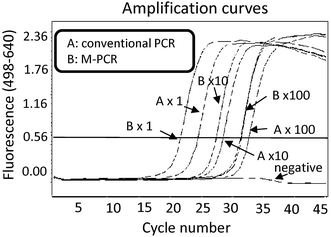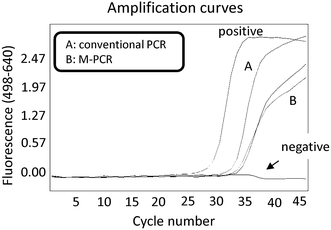Enrichment of bacteria samples by centrifugation improves the diagnosis of orthopaedics-related infections via real-time PCR amplification of the bacterial methicillin-resistance gene
- PMID: 26138214
- PMCID: PMC4490765
- DOI: 10.1186/s13104-015-1180-2
Enrichment of bacteria samples by centrifugation improves the diagnosis of orthopaedics-related infections via real-time PCR amplification of the bacterial methicillin-resistance gene
Abstract
Background: To effectively treat orthopaedic infections by methicillin-resistant strains, an early diagnosis is necessary. Bacterial cultures and real-time polymerase chain reaction (PCR) have been used to define methicillin-resistant staphylococci. However, even when patients display clinical signs of infections, bacterial culture and real-time PCR often cannot confirm infection. The aim of this study was to prospectively compare the utility of real-time PCR for the mecA gene detection following centrifugation of human samples with suspected orthopaedic infections.
Results: In addition to the conventional real-time PCR method, we performed real-time PCR following centrifugation of the sample at 4,830×g for 10 min in a modified real-time PCR (M-PCR) method. We suspended cultured methicillin-resistant Staphylococcus aureus and generated standard dilution series for in vitro experiments. The in vitro detection sensitivity of the M-PCR method was approximately 5.06 times higher than that of the conventional real-time PCR method. We performed bacterial culture, pathological examination, real-time PCR, and M-PCR to examine the infectious fluids and tissues obtained from 36 surgical patients at our hospital. Of these, 20 patients who had undergone primary total hip arthroplasty were enrolled as negative controls. In addition, 15 patients were examined who were clinically confirmed to have an infection, including periprosthetic joint infection (eight patients), pyogenic spondylitis (two patients), infectious pseudoarthrosis (two patients), and after spine surgery (three patients). In one sample from a patient who developed infectious pseudoarthrosis and two samples from surgical site infections after spine surgery, the mecA gene was detected only by the M-PCR method. In one patient with infectious pseudoarthrosis, one patient with infection after arthroplasty, and two patients with purulent spondylitis, the detection sensitivity of the M-PCR method was increased compared with PCR (clinical sample average: 411.6 times).
Conclusions: These findings suggest that the M-PCR method is useful to detect methicillin-resistant strains infections. In addition, the centrifugation process only takes 10 min longer than conventional real-time PCR methods. We believe that the M-PCR method could be clinically useful to detect orthopaedic infections caused by methicillin-resistant strains.
Figures



References
-
- Bulla F, Filippini P. Prosthetic joint infections by multi-drug resistant bacteria. Infez Med. 2010;18(1):5–11. - PubMed
MeSH terms
Substances
LinkOut - more resources
Full Text Sources
Other Literature Sources
Medical

